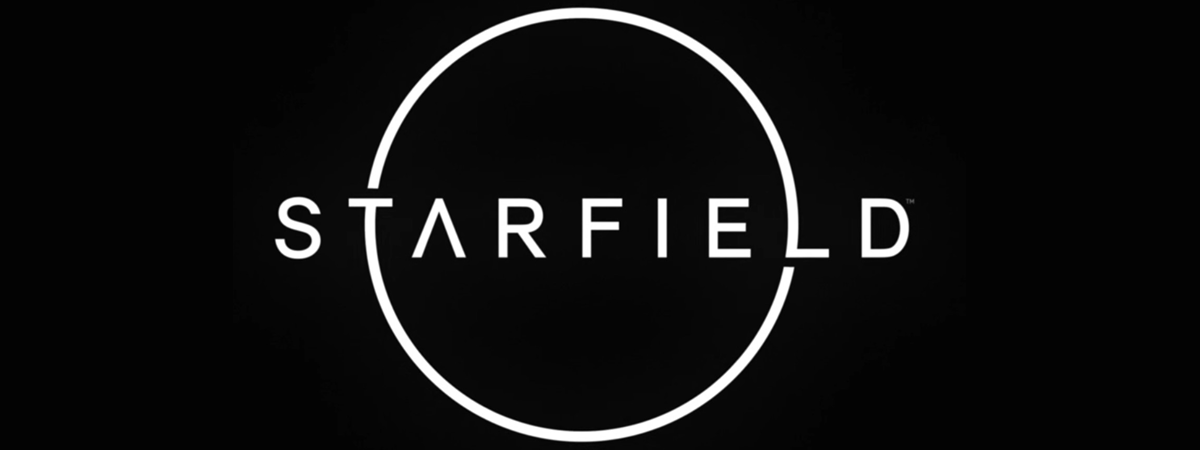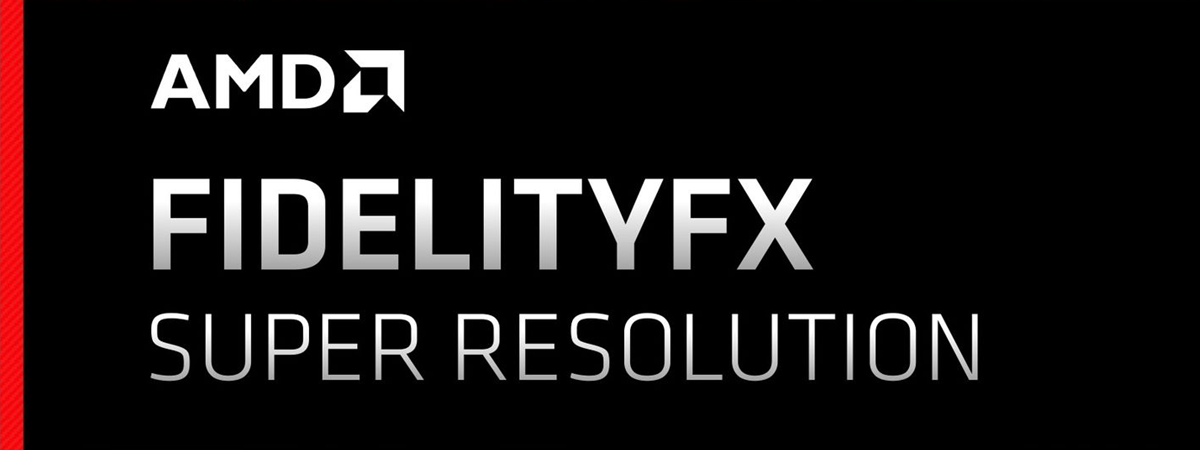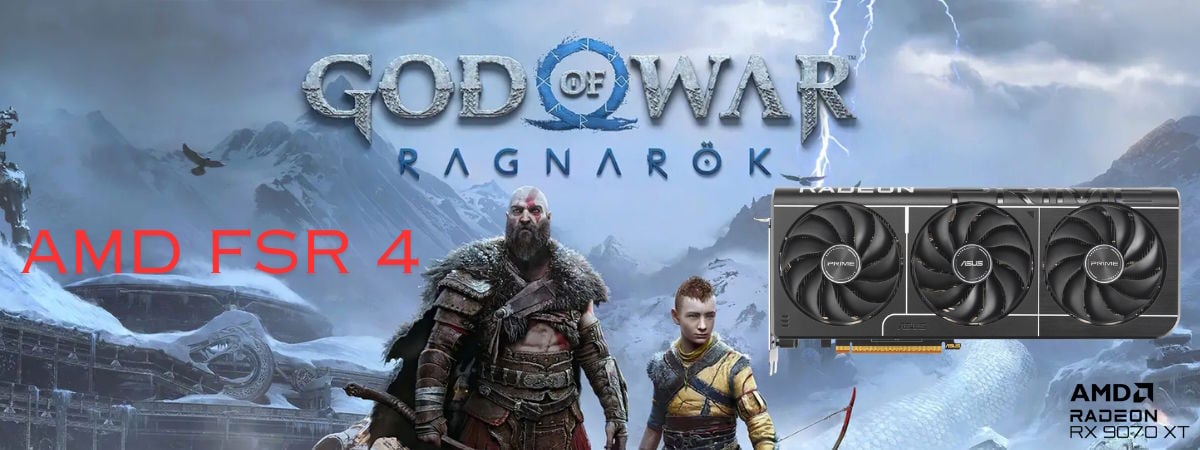
If you’re a gamer, you’ve certainly heard that NVIDIA announced version 4.0 of its Deep Learning Super Sampling (DLSS) technology alongside its upcoming GeForce RTX 50 series of graphic cards. At the same time, AMD demoed their upcoming FidelityFX Super Resolution (FSR) version 4.0 on their upcoming Radeon RX 9070 graphic cards. These technologies can boost graphics performance and image quality, with DLSS relying on specialized AI hardware from NVIDIA GeForce RTX GPUs and FSR being an open-source solution available on all graphics cards. Until DLSS and FSR 4 are launched alongside a new generation of graphic cards, I wanted to see how the existing DLSS 3.5 and AMD FSR 3 compare. I used two entry-level graphic cards (the NVIDIA GeForce RTX 4060 and the AMD Radeon RX 7600) in three games that support both technologies. Here’s what I’ve found:
DLSS 3.5 & FSR 3: Higher framerates for everyone?
Both NVIDIA and AMD provide powerful upscaling technologies. However, they do differ in terms of ecosystem and compatibility. DLSS 3.5 is exclusive to NVIDIA’s GeForce RTX GPUs, requiring specialized AI tensor cores for upscaling and the brand-new Ray Reconstruction feature (in supported games). Meanwhile, AMD’s FSR 3 is open-source and designed to work on a wide variety of GPUs, including older AMD Radeon models, many NVIDIA GeForce cards, and even Intel GPUs. This widespread compatibility makes FSR particularly attractive to gamers who own hardware that can’t run DLSS. In other words, to anyone who doesn’t own an NVIDIA GeForce graphics card.

Recommended GPUs for AMD FSR
Credits: AMD
Just like earlier iterations, both technologies upscale from a lower internal resolution to deliver smoother performance without sacrificing too much visual fidelity. Additionally, both DLSS 3.5 and AMD FSR 3 include frame-generation techniques that can further boost framerates in demanding games. These features are generally recommended for newer GPUs: AMD suggests using FSR 3’s Frame Generation if you have a Radeon RX 5000 series or above, while NVIDIA says you’ll need an GeForce RTX 20-series or newer card to take full advantage of DLSS Frame Generation.

DLSS features in version 2, 3, and 3.5
Credits: NVIDIA
So, while DLSS is NVIDIA-exclusive, AMD FSR can be used on AMD, NVIDIA, and Intel graphics cards. However, for optimal performance, wouldn’t it make sense to stick to each vendor’s recommended solution? Like DLSS on NVIDIA GPUs and FSR on AMD GPUs? This question bugged me, so I decided to answer it by benchmarking a couple of games on both a GeForce RTX 4060 with DLSS 3.5 and a Radeon RX 7600 with FSR 3. But, before I show you what I found, I’d also like to tell you my opinion about the visual quality differences between NVIDIA’s DLSS 3.5 and AMD’s FSR 3.
DLSS 3.5 vs. FSR 3: Which one looks better?
Both these upscaling technologies can work wonders when it comes to increasing framerates, and if you haven’t already witnessed them in action, read the benchmarks section in this article to see what I mean. However, there’s more to the story than raw performance. Visual quality also matters: how crisp everything looks, how well textures are applied and how well they look in motion, and last but not least, how light effects such as reflections or shadows are rendered.
While playing and testing Cyberpunk 2077, The First Descendant, and Star Wars Outlaws, I’ve noticed that the image quality varies a little depending on the upscaling technology you use.
In Cyberpunk 2077’s neon-lit city, details remained well-preserved regardless of whether I used DLSS or FSR. However, on the Balanced preset, I saw a couple of subtle distinctions. With DLSS on, the game renders a slightly crisper image than FSR in areas with lots of detail like text, graffiti, or neon signs, as well as on faraway objects. FSR produces a similar result, and it’s quite hard to see any obvious differences from DLSS if you look at screenshots (still images). However, when lots of movement is involved, I tend to favor DLSS over FSR, as it seems to provide a smoother gameplay that looks better.

Cyberpunk 2077 comparison: Native rendering vs. DLSS vs. FSR
The First Descendant includes lots of high-resolution textures and ray-tracing effects. Here, too, NVIDIA’s DLSS has the tendency to preserve subtle texture details, effects, and edges better than AMD’s FSR. However, FSR does just as good a job, and you can hardly tell the difference. Again, if you’re extremely picky, you may observe some more softness if you look at things up close, like in a zoomed in screenshot. However, it’s not something you’ll notice when actually playing the game.

The First Descendant comparison: Native rendering vs. DLSS vs. FSR
The third game that supports both DLSS 3.5 and FSR 3, which I’ve tested and played, is Star Wars Outlaws. To my surprise, I really like this game, although I’m not a huge Star Wars fan… 🙂 The game offers an open-world adventure with extremely beautiful locations, dense cities filled with all kinds of characters, high-speed traveling while riding your speeder, and even space travels and battles aboard your stolen ship. After playing it for quite a while now, I can say that both DLSS and FSR manage to keep the visual spectacle largely intact and quite close to the original native rendering. NVIDIA’s DLSS can preserve fine detail a little better, especially on clothes, droids, and vehicles. Still, AMD’s FSR is so close that I can’t really tell the difference unless I capture screenshots and analyze them zoomed in.

Star Wars Outlaws comparison: Native rendering vs. DLSS vs. FSR
Overall, in all these three demanding games, I can say that the image quality is a bit better with DLSS versus FSR. However, the visual differences are so small that it’s quite hard to tell them apart in real life. Having said that, let’s move on: first, I’ll show you how I tested DLSS vs. FSR and then see how much of a performance boost you can expect from both upscaling solutions.
AMD vs. NVIDIA: How did I benchmark DLSS 3.5 vs. FSR 3?
Both NVIDIA DLSS and AMD FSR excel in visually demanding titles that can really push a GPU to its limits. For my tests, I used an AMD Radeon RX 7600 and an ASUS Dual GeForce RTX 4060 OC Edition mounted inside a desktop computer with the following hardware configuration:
- Motherboard: ASUS ROG Strix X870-A Gaming WiFi
- Processor: AMD Ryzen 9 9900X
- Cooler: ASUS ROG Ryuo III 240 ARGB
- Memory: Kingston Fury Renegade RGB DDR5-8000
- Storage: Kingston KC3000 PCIe 4.0 NVMe M.2 SSD 2TB
- Monitor: ASUS ROG Strix XG32UQ (4K UHD)
- PSU: Seasonic Focus GX-1000
- Operating System: Windows 11 Pro version 24H2

The computer I used for testing DLSS vs. FSR
The AMD Radeon RX 7600 goes for around 260 USD, while the ASUS Dual GeForce RTX 4060 OC Edition costs about 300 USD. They can both be considered budget GPUs, which makes them interesting choices for gamers who want decent gaming performance while avoiding high price tags.
To compare the results of DLSS vs. FSR, I used three resolutions in the games that I chose: 4K, 1440p, and 1080p, and I tested three different scenarios to see exactly how the performance of FSR and DLSS scales:
- Native game rendering without upscaling and Frame Generation
- Upscaling only (FSR 3 on the Radeon RX 7600, DLSS 3.5 on the GeForce RTX 4060, both in Balanced quality mode)
- Upscaling + Frame Generation
Having said that, below are the results I’ve measured in these graphically intensive games and the conclusions I could draw from them:
DLSS 3.5 vs. FSR 3 benchmark results on the GeForce RTX 4060 & Radeon RX 7600
In Cyberpunk 2077 at a 1080p (ray tracing medium graphics preset), the Radeon RX 7600 starts at 34 fps in native resolution (no upscaling) and goes up by about 79% to 61 fps with FSR in Balanced mode. Enabling Frame Generation increases the framerate to 112, more than triple the initial performance I got without FSR. The GeForce RTX 4060 goes from 42 fps in native resolution rendering to 69 fps with DLSS Balanced (a 64% increase) and then up to 113 fps with Frame Generation enabled. In the end, the GeForce RTX 4060 appears to be 13% faster than the Radeon RX 7600 when using upscaling (DLSS vs. FSR) but only 1% faster when also enabling Frame Generation. In 1440p and 4K, the graphics cards get low average framerates even with upscaling, although there are some percentage gains. Still, I’d say the game is unplayable in these conditions unless you decrease the graphics quality.

Benchmarking Cyberpunk 2077: DLSS vs. FSR
Then, I moved on to The First Descendant, a game that I decided to test using its high graphics with medium-quality ray tracing preset. In 1080p, the Radeon RX 7600 manages to render 43 fps in native resolution and increases by almost 50%, to 63 fps, with FSR Balanced upscaling. Enabling Frame Generation doesn’t increase the number of frames per second in this game. It’s actually a small decrease compared to when using FSR upscaling only, revealing how frame-generation algorithms can sometimes limit the real benefit if the baseline framerate isn’t already solid. In fact, it’s often best to leave Frame Generation off unless your system can consistently maintain around 60 fps or higher. The GeForce RTX 4060 started a little higher, getting 51 fps from the start, with no DLSS involved. Thus, its results were better too, eventually hitting 114 fps with DLSS plus Frame Generation, which is a leap of 124% compared to the original number. Just like for Cyberpunk 2077, in 1440p and 4K resolutions, the two cards managed some improvements when enabling DLSS or FSR, with the GeForce RTX 4060 proving to be particularly faster when DLSS and Frame Generation were combined.

Benchmarking The First Descendant: DLSS vs. FSR
Finally, Star Wars Outlaws at ultra visual settings underlined the strengths and differences of each upscaling technology. In 1080p, the Radeon RX 7600 goes from 28 fps to 35 fps with FSR Balanced, which is an increase of about 25%. Turning on Frame Generation gets the framerate even higher to 76 fps, which is over 170% better than the original result. The GeForce RTX 4060 manages to render 42 fps without DLLS and jumps 48% to 62 fps with DLSS Balanced. It goes even further with Frame Generation enabled also, up to 98 fps, which is 133% more than the initial result (without DLSS upscaling or Frame Generation). In higher resolutions, 1440p and 4K, AMD’s card sometimes showed larger percentage boosts, but they weren’t enough to overtake NVIDIA in absolute framerate numbers. In these resolutions, you should decrease the graphics quality, not to mention that enabling DLSS or FSR plus Frame Generation might prove to be practically mandatory if you want to enjoy a smooth gameplay.

Benchmarking Star Wars Outlaws: DLSS vs. FSR
Overall, it looks like both the AMD Radeon RX 7600 and the NVIDIA GeForce RTX 4060 offer significant performance increases when upscaling and Frame Generation are enabled. So…
Which offers better performance? DLSS 3.5 or FSR 3?
Averaging results across all these games and resolutions yields the geometric means shown in the table below (for the Balanced preset):
- At 4K resolution, the GeForce RTX 4060 often gets you larger raw numbers, but the Radeon RX 7600 can see even higher percentage gains from Frame Generation, in some cases.
- At 1440p resolution, both graphics cards give you a significant jump in framerates when upscaling is applied. DLSS can deliver slightly higher fps, but FSR also comes close with Frame Generation.
- At 1080p, the GeForce RTX 4060 is generally ahead, though the Radeon RX 7600 is not far behind, especially considering its lower price.

NVIDIA DLSS 3.5 vs. AMD FSR 3
In other words, averaged across all three titles in the three different resolutions I tested, I could say that the GeForce RTX 4060 is a winner in raw framerates. Still, the Radeon RX 7600 sometimes delivers larger percentage increases with FSR 3, especially when Frame Generation is enabled. That’s good news for gamers who don’t have generous budgets, as they can take advantage of a less expensive GPU yet still see big performance boosts when turning on FSR. If you value absolute fps and have a modern GeForce RTX card, NVIDIA DLSS 3.5 remains your best bet. Meanwhile, if you own an AMD Radeon card, then FSR 3 is a strong all-around solution. Regardless of which path you choose or you’re already on, it’s quite clear now that upscaling plus Frame Generation can positively transform your gaming experience in even the toughest titles.
What’s your opinion about DLSS 3.5 vs. AMD FSR 3?
Having reached the end of this small experiment, I hope my findings make it easier for you to choose the right upscaling technology for your computer and favorite games. Before you go, would you mind answering a few questions I have for you? Are you an AMD or NVIDIA fan? Do you have a GPU that supports DLSS or FSR, and which games have you tested these technologies in? Did you notice significant performance improvements when you turned on Frame Generation? Let me know in the comments section below.


 10.01.2025
10.01.2025 

